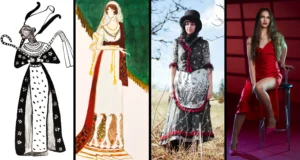Did you ever wonder why some sisters swish in starch white while others opt for darker dyes? As any amateur fashionista knows, there’s a method in these monochromatic modes.
Centuries of tradition first account for tonsures tailored to various vows – Dominicans dawned dove white since ancient ages while Carmelites clung to earthen shades.
Yet deeper meaning also marks the hues. Down south, billowing beiges bail nuns from the blistering sun. And symbolism sews stories into stuff – white washes wearers in purity’s glow where grimmer greys call minds to mourn.
But what spawns such splendorous spans? Join me on a voyage tracing the rich religious roots nourishing such remarkable robes!
Why do some nuns wear white?
Symbolize purity, innocence, and novices’ beginning.
The white habit novice nuns wear represents purity, innocence, and a fresh start. White is the color of light and new beginnings, like a blank page ready to be written on.
The habit is like a clean slate for the young women just embarking on their journey in religious life as novices. It reminds them each day to live simply and maintain the purity of heart as they discern their calling. More than that, it serves as a symbol of hope.
Even in a world that can seem dark at times, the white habit symbolizes the hope for redemption and renewal that these novices bring with them. It shows their commitment to building a better future through their faith, just as new snow makes everything feel bright.
Most of all, the pristine white is a reflection of the novice’s untouched soul and her desire to grow closer to God one step at a time.

Associated with the joy of the resurrection and new beginnings
The pristine white habit worn by novice nuns symbolizes so much hope. White represents renewal and new beginnings – just like the rebirth celebrated every Easter.
When wrapped in this luminous garment, the novices are reminded of Jesus’s victory over death, which gives us all hope of what’s to come.
More than that, the immaculate white challenges its wearer to pursue purity and innocence in their actions each day.
Just as that first Easter heralded a clean slate from sins, the crisp white habit grants its novice a fresh start on their journey. They embark with renewed purpose, seeking to mirror Christ’s perfection in all they do.
Seeing the nuns dressed in radiant white evokes powerful images of resurrection and redemption. It reflects their passion to spread this hope wherever they go.
Though new to their calling, the promises their pure white represents brighten each step the novices take. This simple color is a profound reminder of why they dedicate their lives to service.
Wear white veils to represent their initial stage of formation
The immaculate white veil and wimple worn by novice nuns hold significant meaning. These garments signify the critical period of spiritual formation they are embarking on.
Being new to religious life, the pristine white represents their innocence and purity of heart as they discern their calling.
Though in the beginning stages, the novices have great commitment reflected in their crisp white head coverings. Whether a simple veil or one trimmed in lace, these declare the promise made to dedicate fully to their faith.
Wrapped devoutly over their head and shoulders, the virginal hue remains a constant reminder of this pledge daily.
As the novices persist in their studies and practices over time, progressing in knowledge and virtue, their veiling may darken to black or brown. This subtle change marks their deepening understanding of the order.
Yet the initial white signifies such an auspicious start, symbolizing the hopes and foundations that ground each woman’s journey ahead.
Reflect the beliefs and values of certain religious orders
The white habit worn proudly by Franciscan nuns deeply reflects the values central to their religious order. Simplicity, humility, and faithful devotion to God are most important to the Franciscans. By following Christ’s example of poverty, they voluntarily embrace modest living.
The pristine white worn by these sisters outwardly display their commitment to living according to the Franciscan way.
Free of adornment, the immaculate color symbolizes purity of spirit and an uncluttered life focused on prayer over possessions. Whether in tasks or worship, they remain undistracted from their core purpose.
More than just a habit, the brilliant white represents the Franciscans’ reverence for their founder Saint Francis and his radical teachings of serving God above all.
Its snowy hue keeps them mindful of imitating Jesus in both word and deed. Their values shine through in this simple yet powerful uniform for all to see.
Why do some nuns wear black?
Symbolize humility, penance, and complete dedication to God
The austere black habit worn by professed nuns profoundly signifies their dedicated vocation. This somber hue symbolizes complete surrender to God through humility, penance, and detachment from worldly concerns.
In choosing the simple black garment, the nun publicly demonstrates her death to self and old ways. She embraces a life focused solely on spiritual service, constantly reflecting on her deep need for divine mercy.
Further, the habit reminds her of her sacrifice—living merely to fulfill God’s will became her sole joy.
More than clothing, the habit becomes an outward expression of the nun’s inner transformation. United with her sisters through their shared commitment, she finds purpose in Helper of prayer.
Whether amidst daily chores or devotions, the habit’s dark color prevents any distraction from Christ’s presence. Now wedded to her faith in solemn vows, she receives this robe as a bridal dress for her holy marriage.

Worn by professed nuns who have made permanent vows
The severe black habit worn by professed nuns outwardly demonstrates the profound dedication within. These sisters have permanently pledged their lives to faith through solemn vows.
They publicly embrace humility by choosing the somber yet durable garb, living apart from worldly distractions. The habit also symbolizes their constant desire to seek God’s mercy through self-sacrifice.
Further, the modest uniform allows total concentration on service without concern for appearance.
United under their shared commitment, the nuns find community. They wear the same dark robes as beacons of their order’s core principles.
Whether at work or in prayer, the habit reminds each woman of her “death” to all but Christ. Having relinquished all bonds, their entire beings now belong to Him alone.
This simple dress thus becomes a powerful sign, outwardly reflecting an inward reality of unwavering and complete contribution to the Divine. Through it, the sisters live and walk as visible brides of their beloved Groom.
Mourning, detachment from worldly desires
The sober black habit worn by professed nuns makes a profound statement about their commitment and priorities. This somber hue emphatically represents detachment from temporal pleasures through its ties to mourning and death.
The sisters publicly embrace their symbolic “passing” from worldly attachments by embracing the simple, unadorned robe. The grave color is a constant reminder of life’s impermanence and their vow to pursue eternal rewards over fleeting delights.
Further, the habit shows their rejection of status-driven fashions to instead dedicate each moment to advancing spiritually.
Having renounced personal claims, the nuns unite as a community of thought. United in somber suits mirroring their interior disposition, they walk as beacons inspiring others with their ‘death’ to selfishness.
Freed from distraction, their singular passion becomes advancing His kingdom through prayer and service with steadfast focus. The austere robe thus outwardly manifests an absolute relinquishment of ego.
Symbol of simplicity and repentance in monastic orders
The humble black habit takes on profound significance for nuns living within monastic communities. This austere garb outwardly demonstrates an inward disposition of utter simplicity and continual repentance.
These sisters publicly embrace lives free of excess or distraction by choosing the unadorned, somber robe. The modest uniform focuses solely on spiritual betterment instead of worldly attractions.
Within the order’s isolated sanctuary, the habit is a constant reminder to nourish penitent hearts through prayer and self-denial.
Furthermore, donning identical dark garments, the nuns manifest unity of purpose. United under their shared commitment to replicate Christ’s example of poverty, they encourage one another in sustaining dedication.
Whether amid daily routines or special prayers, the habit grounds each woman anew in her call to expiate sins through devoted worship. In this way, the noble black serves its noble aim.
Provide a sense of identity within the religious community
For nuns living within a religious community, the sober black habit takes on additional importance beyond its spiritual symbolism. Wearing this same somber attire allows the sisters to identify with one another and strengthens their bond of union.
When these women come together dressed in dark robes, they are visibly reminded that though diverse in backgrounds, they have chosen the same sacred sisterhood.
United under their shared commitment, companionship sustains each person in difficult times. On days with challenges large or small, glancing at identical garb worn by those nearby reaffirms that all are fellow travelers on the one holy path.
Furthermore, within the convent’s sequestered setting, habiting reinforces core values through daily examples. Living simply as “brides of Christ”, the habit permits total focus on mutual aid instead of personal adornment.
Its dark tone fosters mindfulness that souls aim higher than fleeting pleasures or individual concerns. Together, the sisters draw nearer their Groom through this simple yet profound act of outward conformity.
Other factors of some nuns wearing white and some wearing black
Tradition
Religious orders like the Dominicans have maintained traditions establishing each community’s unique identity for centuries. Their founder Saint Dominic established the Sisters wearing pristine white to honor purity’s dignity.
Through the ages since this dedicated lineage of women upholds their virtue-signifying shade as a bond with devoted souls long past.
Likewise, Carmelite Sisters follow the precedent instituted by Saint Teresa of Avila, donning earthy brown to outwardly embody humility and contemplation’s call.
Within the sheltering walls of the monastery, generation after generation renews their connection to spiritual foremothers by dressing in the very habit authorized so long ago.
Such consistencies of custom enduring centuries attest to tradition’s power to preserve an inheritance of profound faith across the shifting sands of time.
For these sisters, vibrant history lives on through familiar habits, still linking each new handmaid to saints who established their distinguished paths to God through simple acts of ordered uniformity.
Climate
For nuns embracing simple vocations worldwide, even practical concerns like climate influence habit decisions carefully made. Luminous robes may shield tropical sisters, while somber shades suit colder sisters better.
Whether the Dominican warmly embraces light tunics in Latin lands under the relentless sun or the Carmelite layers darker wool against Siberian gales, each habit aids focus on faith undistracted by nature’s vicissitudes.
Beyond symbolism, adaptability ensures physical comfort allowing full concentration on devoted tasks rather than thermal trials.
Unvarying in religious spirit yet flexible concerning sensible needs, these women demonstrate practical piety through habits harmonizing with their surroundings.
Whether summer’s brilliant white or winter’s cozy brown, their optime outfitting permits sole mindfulness of Him, and they serve through any season with serene stability.
Cultural and Historical Factors
Within the intricate tapestry of religious history, each order weaves its unique identity through symbolism deep-rooted over centuries. Traditions like the Carmelites and Dominicans chose varying hues, each inspired by cultural roots and founders’ vision.
For the Carmelite sisters, embracing earthen tones of brown connected them to their land’s essence, renouncing riches for humble simplicity. Their nature-near gowns proclaim values kindred to the soil from which humanity springs.
Meanwhile, the Dominicans dawned in luminous white as beacons of purity spreading faith’s radiance, in keeping with paths blazed by their originator, Saint Dominic himself.
Thus, whether moving shoulders draped in ash or earth, habits deliberately designate each cluster of women within religion’s sprawling fabric.
Preserving sacred threads from previous believers, modern sisters stand thread-linked to those pioneering exemplars who stitched meaning into even modest textiles through dedicated lives of service so long ago.
Order’s Beliefs
For religious sisters, the habit is more than mere attire but an outward manifestation of inner convictions. Each order deliberately chooses hues representing their unique nature and aspirations.
The Carmelites, for instance, adopt humble brown to mirror their emphasis on earthbound simplicity and prayer. With this tone evoking the soil from which all creation springs, their robes call to remembrance humankind’s lowly origins and dependence upon the Divine.
Meanwhile, Dominicans don radiant white, its luminous purity amplifying their commitment to shining God’s hope worldwide. Visible for all to see, this vibrant shade echoes their founder’s belief in grace’s power to illuminate and transform.
Thus, through deliberate decisions regarding even small details like dress, these orders indicate what most inspires their purpose. For viewers and members alike, habits offer profound insight into each community’s character in a means as understandable as it is under spoken.
Order’s Identity
For sisters living within the cloistered fold, identity springs not from externals but from values shared amongst the flock. Unifying habiliment knots each nun fast to her sisters via symbolism’s subtle threads.
Whether Carmelite daughters don earthy brown evoking simplicity collectively embraced or Dominican charges dawn pure white proclaiming the sacred charge of hope, familiar mantles reinforce treasured traits uniting the whole.
Beyond frills, this uniform humbly declares the chosen virtues vivified through community instead of a solo effort.
Furthermore, in the haven of the convent, catching a glimpse of one another robed in faithful likeness strengthens resolve. When challenges arise, one needs merely glance at garb mirroring that donned by those who understand life’s meaning best to feel fortified anew.
Bonds of belief trump superficiality; here, singing in sweet harmony springs from singing from the same well-worn score.
Thus habit serves its highest use, outwardly echoing within each sheltered soul a song only deepening through the sisterly refrain.
Other colors that nuns wear instead of white and black
Blue color
While many assume strict sisters don solely white or black, their color partitions the multitude as insight reveals. Mother Teresa’s missions opt for patterns pairing blue with purity’s complemented snowy white, honoring heavenly patron ness acclaimed by the Queen of Angels.
This deliberate dye stakes profound significance beyond aesthetics alone. Recalling the Virgin’s trustworthy tenderness, such robes call women to channel her merciful heart, easing all ills encountered with sky-hued solicitude.
Beyond symbol, practical points prove blue’s worth too; where torrid lands bake, this refreshing shade shelters from sunlight’s harsh glare.
Furthermore, unique numerals find within the vast family of various flocks favor Fortuna’s favorite hue simply due to its tranquil tone.
Calm waters quench the soul as calm hues soothe the mind, permitting a full focus on sacred care unperturbed by passion’s noise. Thus diverse colors unite toward one sole end: uplifting every soul with the light of selfless ministry.
Brown
While many envision strictly somber or pure attire, diversity runs deep as orders adopt varied hues. Tradition finds the Carmelites robed in earthy brown since antiquity, honoring values of humility.
This modest mantle calls the wearer to reconnect with nature’s essence, finding solace in soil nourished by centuries of faithful feet. Beyond mere shades, deeper intentions are sown; for sisters secluded in rugged lands, camouflage blankets utility and anonymity prized.
Likewise, medieval maidens garbed in kindred tones tread nature’s realm unfettered, hearts soft as the grass yet resilient as rockbound roots. Personal preference also plays a role, as some find Brown’s stable calmness suits religious spirit best.
Regardless of factors, all habits uniformly till the same garden – that within each devoted woman. As years bloom virtues through obedience, onlookers become living flowers bloomed from dirt, spreading goodness’ fragrance across the ages.
Green
Amidst religion’s timeless tapestry, diversity thrives as orders opt for varied shades to suit their calling. The Sisters of Charity don verdant robes embraced since the nineteenth century, their lively leafy layers signifying perennial hope.
For these women, the renewing tint echoes virtues in which they root – guiding tendrils of aid wherever wants may wound. Beyond aesthetics, practical points commend the refreshing hue in regions Hot Sun incessantly glares upon convent walls.
What’s more, Nature’s foster daughters feel Nature’s affinity, blending with greensward whether in garden or village paths.
Thus varied motivations seed different fraternal fields yet all bear fruit notable – wherever charitable hands till barren earth, from furrows flowers burst which soothe and bless. Hence diversity’s richness serves to spread one singular message through dissimilar stems, as varied habits house identical seeds of selfless love.
Grey
While societal standards sing of stark simplicities, religious women write richer refrains through varied voices. The Poor Clares exhale neutral notes since Francis’ noble time, their misty mantles memorializing humility sought in detachment’s lofty realm.
This muted melody guards the spirit from passing pleasures of material realms below. Furthermore, for sisters straying where rural landscapes stretch far as heaven’s arch, camouflage offers safety’s sanctuary when charity calls to the world’s wild edges.
Likewise, within the city’s cacophony some sisters band softening strains, their unobtrusive shades allowing near invisibility as vulnerability is veiled and wants are walked with.
Thus diverse motivations seed diverse shades yet all cultivate Concord’s crop, helping hands outstretched where lives feel barren of hope’s hymn. Dissimilar in tones, one in tone – to raise each soul through the loving gift of song.
Purple
While societal standards often see sisters dressed in cool hues alone, diverse shades in fact adorn devoted women down history’s halls. Case in point, regal Benedictines since ancient ages don violet vespers connecting to Christ’s line through prayer and praise.
This majestic dye hints at nobility within, raising eyes upward as the heart ascends.
In practical terms, too, the lilac living veil sun’s blistering beams permit focused fervor even under scorching skies. And when serving vulnerable folk, inconspicuous plum plumes let good works blossom unseen.
Elsewhere, varied motives merge – tradition guiding Ursulines as justice becomes their song, their purple proclamations teaching truth’s tunes with tact.
Among Holy Spirit sisters too, elegant violet lets mercy masquerade where misfortune reigns. Thus reasons range yet resolve remains unchanging – through each order’s flowering faith, hope’s harvest is higher raised.

Summary
The monochromatic mystery of nuns’ attire reveals both tradition and symbolism. Dominicans have dawned pure white since ancient times, symbolizing purity and new beginnings.
Meanwhile, the Carmelites embrace earthy brown, reflecting humility and simplicity. Climate shapes habits as well, with beige for sun protection and somber hues for colder climates.
These habits go beyond clothing; they embody commitment and identity within religious communities. Whether in white or black, each habit tells a story, a testimony to values, faith, and devotion that endure through the ages.
FAQ
What order of nuns wear all white?
The Dominican Sisters, Salesian Sisters, Cistercian Nuns (Trappistines), and certain branches of Carmelite Nuns, such as the Discalced Carmelites and the Carmelite Sisters of the Divine Heart of Jesus, wear all-white habits. These orders, each with their unique focus and history, don the color white as a symbol of their dedication to preaching, education, contemplation, and spiritual formation.
What nuns wear blue and white habits?
The Missionaries of Charity, founded by Mother Teresa, don blue and white saris as a distinctive habit symbolizing their commitment to aiding the destitute. Similarly, the Sisters of Mary Reparatrix wear white habits with blue scapulars, veils, and a golden heart on the breast. Additionally, certain branches of Cistercian nuns may adopt blue and white habits, although the predominant attire for most Cistercian nuns remains all white, aligned with their contemplative lifestyle.
What do nuns call each other?
Nuns often refer to each other as “Sister.” Using the term “Sister” signifies respect and acknowledges their shared commitment to religious life. While both nuns and sisters are consecrated women religious, the term “sister” is commonly used to refer to all women religious, while “nun” refers specifically to those who live a contemplative and monastic lifestyle.
What is a male nun called?
The male equivalent of a nun is typically called a “monk.” While the term “nun” specifically refers to women who live a contemplative and monastic lifestyle, men who take similar religious vows may be referred to as monks. It’s important to note that the terminology may vary depending on the specific religious tradition or order.
Why do nuns have to cover their hair?
Nuns cover their hair for reasons deeply rooted in their faith and tradition. This practice symbolizes modesty and humility, shifting focus from appearance to spirituality. It also signifies consecration, marking their commitment to the religious order and a life of devotion to God. Visually distinct, it sets nuns apart and reflects their religious calling. This historical custom originates from biblical references like 1 Corinthians 11:4-6, highlighting the significance of head coverings during prayer, perpetuating a spiritual connection through the ages.



